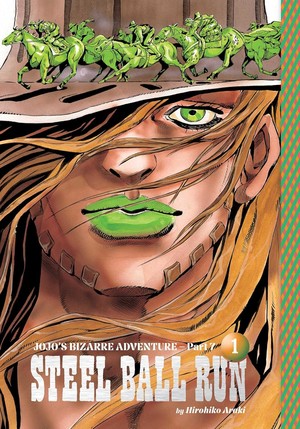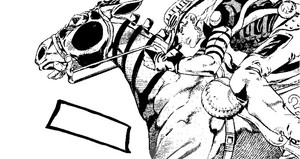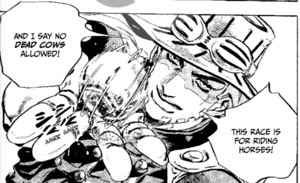The Spring 2025 Manga Guide
JoJo's Bizarre Adventure Part 7: Steel Ball Run
What's It About?

JoJo's Bizarre Adventure Part 7: Steel Ball Run has a story and art by Hirohiko Araki, with English translation by Nathan A. Collins. This volume was lettered by Mark McMurray. Published by Viz Media LLC (May 27, 2025). Rated T+.
Is It Worth Reading?
Christopher Farris
Rating:

To hear Hirohiko Araki tell it in the author's notes at the end of this volume, Steel Ball Run was "in essence" written as Part 7 of JoJo's Bizarre Adventure, but he wanted to de-emphasize the connection for the sake of new readers. While SBR has gone on to be unquestionably known as a part of the realities-spanning JoJo's saga, the air of new invention is still very much about it in this opening leg of its extremely long horse race. Some characters have names that resemble recurring JoJo's stars, but who they actually are and how they engage with each other has been radically rebuilt.
Stands are virtually absent from the story at this stage—though a couple of presences resemble them. The lack of complex power sets to drive the more cerebral mind-game battles that defined the latter JoJo's parts means that things are very back-to-basics for SBR. As back-to-basics as a series that features a character riding a horse that ends up surfing a cow carcass down a mountain can be, anyway. It's not even a series about direct combat yet, being effectively more of a sports manga accentuated by that Araki flair. That's all fine, this is a manga defined by near-constant movement once the racing gets underway, as technical horse-racing tricks pile up alongside the twisted masses of crashed-horse chaos. It's accentuated with abilities of dumb luck and creative application of (spinning metal) balls. Araki, as always, loves balls.
Ever an artist seeking to challenge himself, Araki has committed to drawing a series requiring him to draw pages upon pages of lots of running horses. Ambitious, but it's paid off well. Everything is always moving in SBR, embodied in those spinning balls of Gyro Zeppeli. The more straightforward, Stand-power-less action means things haven't gotten as complex to follow as in previous parts. Still, in fast-moving scenes where things might be trickier to track, the public race framing provides the perfect vector for in-universe narration. It all has flavor, even as this early stage is simply all about showing off as much rapid-fire horse race action as possible. But as evidenced by the lengthy lead-up to said race kicking off, this story is in for the long haul. There will be plenty of space for a deeper examination of Gyro, Johnny, and the others. Johnny in particular has fascinating potential as an ostensible protagonist JoJo, so it's a little disappointing he's left behind mostly as an observer for this volume. But it all speaks to how well SBR works as an ensemble piece—a rollicking celebration of, as Araki calls it, "the bizarre race that is life."
Lauren Orsini
Rating:

I've read or watched every JoJo's Bizarre Adventure installment since Phantom Blood. I thought to myself, I will be prepared for anything that JoJo's Bizarre Adventure: Steel Ball Run can throw at me. Readers, I was a fool. Immediately starting with its opening salvo, this manga is explosively weird (one might even say bizarre) with a style that is certainly typical of previous JoJo arcs, but with an inventive streak that separates it from anything that came before. If you are familiar with JoJo stories, you will recognize Steel Ball Run's imaginative worldbuilding, larger-than-life characters, and crude sense of humor. But you will not be able to predict what will happen next. Despite its delightful strangeness and originality, some localization choices kept me from giving this a higher score.
Steel Ball Run feels like creator Hirohiko Araki's attempt at creating a tall tale that fits into the canon of the American West—an attempt I'd call wholly successful. Araki has a knack for presenting larger-than-life characters with unbelievable abilities, very much in the narrative tradition of American folk heroes like Johnny Appleseed and Paul Bunyan. The time frame is right—1890 is the perfect era to convey a nostalgia for this country's gritty, pioneering days. At the center of the story is the Steel Ball Run itself, a no-holds-barred race across the continent for a grand prize of $50 million. Paraplegic ex-jockey Johnny Joestar ought to be the star of the story by name alone, but has to fight for relevance against multiple myths in the making. There's Gyro Zeppeli, whose outlandish name gives a hint of his next-level abilities with projectiles. There's Pocoloco, a Black emancipated farmer who has maxed out his luck stat. There's Sandman, an Indigenous person who has developed a running style that can rival any horse. Amidst the action, there's a lot of JoJo-typical grossness to contend with. When you're not goggling over promoter Steven Steel and his child bride, get ready for a lot of poop jokes.
In the postscript, Araki writes that his intention was for Steel Ball Run to be a gateway to his JoJo series, no remedial reading required. I'm not sure how well it succeeds in this regard. Though it isn't a direct continuation, there are direct ties to the series protagonists and antagonists JoJo and Dio, though it's still not clear if the characters who share their names also share their blood. There are also power-up shenanigans that can't be mistaken for anything but Stands. I'd recommend this manga to people who are already familiar with the JoJo-verse, with one caveat: get ready for some weird distance conversions. Even though Araki told the original story in kilometers, the English version uses miles, leading to such oddities as characters swiftly approaching the pivotal “1.25 mile marker,” which you're unlikely to see in any race. I assure you by the time you're 2.15 miles into the story, it's not so grating.
discuss this in the forum (28 posts) |
back to The Spring 2025 Manga Guide
Seasonal homepage / archives